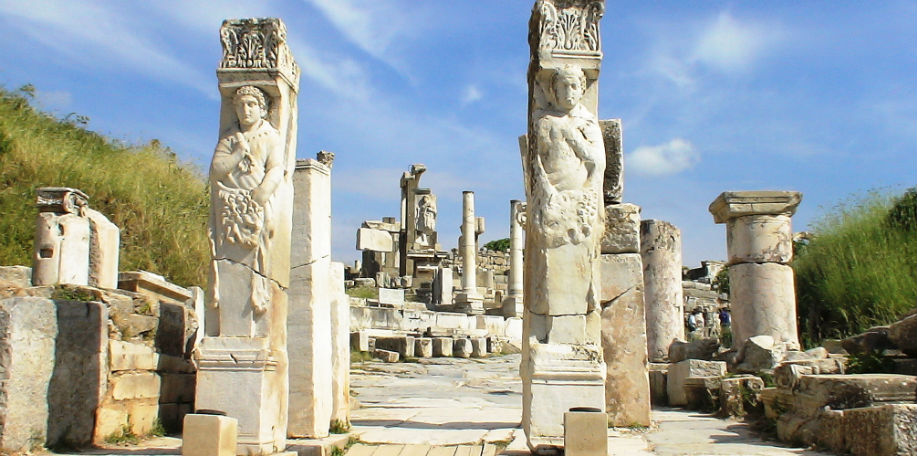On the street running downwards from the Memmius Monument stands a monumental gate thought to be built in the 5th century. Only two lintels of the gate have been remounted in Ephesus. The gate was named after two reliefs on these lintels which showed Hercules draped in a lion skin. Hercules Gate was constructed with two tiers of columns. The block found in the Domitian Square with Hike in a flying posture holding a wreath in her hand was on the second storey of the gate.
The reliefs of Hercules Gate on the lintels are dated back to the 2nd century because of the style. Therefore, with great probability they belong to a structure which was destroyed in the 4th century earthquakes. They must have been brought here later when this gate was built. As this section of the road was narrowed because of the building of the gate and as stairs were built on each side of it, it is understood that the Curetes Street was closed to wheeled traffic in the 5th century.
Hercules Gate,


Lovely Ancient Place. Mythological tales on Hercules are always fascinating.
Towards the end of the Augustan era, at the upper northwestern end or the Curetes Street beyond the Heracles Gate close by the old Hellenic Basilica, work was started on a memorial honoring the earlier military victories or the dictator Lucius Cornelius Sulla (138-78), his son Gaius Memmius (111-99), and the Memmius family.
The memorial facing Curetes Street stood raised on a pedestal with steps on four sides ascending to it, each side with arches and semicircular naves containing block figures of those honored.
Hercules Gate located towards the end of the Curetes Street, it was called the Hercules gate because of the relief of Hercules on it. It was brought from another place in the fourth century AD to its current place, but the relief on it dates back to the second century AD.
Only the two side of the columns remain today and the other parts of it have not been found. The relief of the flying Nike in the Domitian Square is thought to also be a part of this gate.
The Heracles Gate narrowed the access to the street, preventing the passage of vehicles.We can understand that from the Fourth Century, the street had become a pedestrian area. In these reliefs Heracles was depicting with the skin of the Nemean lion in mythology. The Nemean lion had been terrorizing the area around Nemea, and had a skin so thick that it was impossible to kill it. Finally he wrestled the lion to the ground, eventually killing it by thrusting his arm down its throat and choking it to death. Heracles was the god of power and strenght.
Hercules Gate Ephesus. In these reliefs Heracles was depicting with the skin of the Nemean lion in myhtology. The Nemean lion had been terrorizing the area around Nemea, and had a skin so thick that it was impossible to kill it. Finally he wrestled the lion to the ground, eventually killing it by thrusting his arm down its throat and choking it to death. Heracles was the god of power and strength.
Hercules Gate Ephesus. Located at the end of Curetes street, the Heracles Gate narrowed the access to the street, preventing the passage of vehicles, making the rest of the way a pedestrian area.